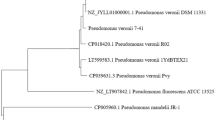Abstract
The chlorinated insecticide γ-hexachlorocyclohexane (γ-HCH) is sequentially metabolized by the products of linA, linB, linC, linD, linE, and linF genes to β-ketoadipate, which is subsequently mineralized. Two or more copies of these genes are present in the bacterium Pseudomonas aeruginosa ITRC-5 that was isolated earlier by selective enrichment on technical-HCH. At least one copy of linA, linB, linC, linD, and possibly linE is lost from ITRC-5 upon its growth on γ-HCH. All the lin genes, however, are lost when the bacterium was grown in Luria–Bertani (LB) medium. The loss of lin genes is accompanied with the loss/rearrangement of insertion sequence IS6100 genes. Concomitant to the loss of lin genes, the degradation of HCH-isomers by “γ-HCH grown cells” is slower, when compared with “technical-HCH grown cells”, and is completely lost by “LB-grown cells”. The selective loss of lin genes during different growth conditions has not been reported before and is expected to help in understanding the dynamism of degradative genes.






Similar content being viewed by others
References
Boltner D, Moreno-Morillas S, Ramos JL (2005) 16S rDNA phylogeny and distribution of lin genes in novel hexachlorocyclohexane-degrading Sphingomonas strains. Environ Microbiol 7:1329–1338
Ceremonie H, Boubkari H, Mavingui P, Simonet P, Vogel TM (2006) Plasmid encoded γ-hexachlorocyclohexane degradation genes and insertion sequences in Sphingobium francense (ex- Sphingomonas paucimobilis Sp+) FEMS Microbiol Lett 257:243–252
Dennis JJ (2005) The evolution of IncP catabolic plasmids. Curr Opin Biotechnol 16:291–298
Dogra C, Raina V, Pal R, Suar M, Lal S, Gartemann KH, Holliger C, Van der Meer JR, Lal R (2004) Organization of lin genes and IS6100 among different strains of hexachlorocyclohexane-degrading Sphingomonas paucimobilis: evidence for horizontal gene transfer. J Bacteriol 186:2225–2235
Endo R, Kamakura M, Miyauchi K, Fukuda M, Ohtsubo Y, Tsuda M, Nagata Y (2005) Identification and characterization of genes involved in the downstream degradation pathway of γ-hexachlorocyclohexane in Sphingomonas paucimobilis UT26. J Bacteriol 187:847–853
Gupta A, Kaushik CP, Kaushik A (2000) Degradation of hexachlorocyclohexane (HCH; α-, β-, γ- and δ-) by Bacillus circulans and Bacillus brevis isolated from soil contaminated with HCH. Soil Biol and Biochem 32:1803–1805
Kumar M, Chaudhary P, Dwivedi M, Kumar R, Paul D, Jain RK, Garg SK, Kumar A (2005) Enhanced biodegradation of β- and δ-hexachlorocyclohexane in the presence of α- and γ-isomers in contaminated soils. Environ Sci Technol 39:4005–4011
Kumari R, Subudhi S, Suar M, Dhingra G, Raina V, Dogra C, Lal S, Van der Meer JR, Holliger C, Lal R (2002) Cloning and characterization of lin genes responsible for the degradation of hexachlorocyclohexane isomers by Sphingomonas paucimobilis strain B90. Appl Environ Microbiol 68:6021–6028
Lal R, Dogra C, Malhotra S, Sharma P, Pal R (2006) Diversity, distribution and divergence of lin genes in hexachlorocyclohexane-degrading Sphingomonads. Trends Biotechnol 24:121–130
Mahillon J, Chandler M (1998) Insertion sequences. Microbiol Mol Biol Rev 62:725–774
Marmur J (1961) A procedure for the isolation of deoxyribonucleic acid from microorganisms. J Mol Biol 3:208–218
Miyauchi K, Suh SK, Nagata Y, Takagi M (1998) Cloning and sequencing of a 2,5-dichlorohydroquinone reductive dehalogenase gene whose product is involved in degradation of γ-hexachlorocyclohexane by Sphingomonas paucimobilis. J Bacteriol 180:1354–1359
Miyauchi K, Lee HS, Fukuda M, Takagi M, Nagata Y (2002) Cloning and characterization of linR, involved in regulation of the downstream pathway for gamma-hexachlorocyclohexane degradation in Sphingomonas paucimobilis UT26. Appl Environ Microbiol 68:1803–1807
Miyazaki R, Sato Y, Ito M, Ohtsubo Y, Nagata Y, Tsuda M (2006) Complete nucleotide sequence of an exogenously isolated plasmid pLB1 involved in the degradation of gamma-hexachlorocyclohexane. Appl Environ Microbiol 72:6923–6933
Mohn WW, Mertens B, Neufeld JD, Verstraete W, de Lorenzo V (2006) Distribution and phylogeny of hexachlorocyclohexane-degrading bacteria in soils from Spain. Environ Microbiol 8:60–68
Nagata Y, Ohtomo R, Nariya T, Fukuda M, Yano K, Takagi M (1993) Cloning and sequencing of a dehalogenase gene encoding an enzyme with hydrolase activity involved in the degradation of γ-hexachlorocyclohexane (γ-HCH) in Pseudomonas paucimobilis. J Bacteriol 175:6403–6410
Nagata Y, Miyauchi K, Takagi M (1999) Complete analysis of genes and enzymes for γ-hexachlorocyclohexane degradation in Sphingomonas paucimobilis UT26. J Ind Microbiol Biotechnol 23:380–390
Okeke BC, Siddique T, Arbestain MC, Frankenberger WT (2002) Biodegradation of γ-hexachlorocyclohexane (lindane) and α-hexachlorocyclohexane in water and a soil slurry by a Pandoraea species. J Agric Food Chem 50:2548–2555
Sambrook J, Russell DW (2001) Molecular cloning: A laboratory manual, 3rd edn. Cold Spring harbor Laboratory, New York, NY
Sahu SK, Patnaik KK, Sharmila M, Sethunathan N (1990) Degradation of alpha-, beta-, and gamma-hexachlorocyclohexane by a soil bacterium under aerobic conditions. Appl Environ Microbiol 56:3620–3622
Senoo K, Wada H (1989) Isolation and identification of an aerobic gamma-HCH decomposing bacterium from soil. Soil Sci Plant Nutr 35:79–87
Springael D, Top EM (2004) Horizontal gene transfer and microbial adaptation to xenobiotics: new types of mobile genetic elements and lessons from ecological studies. Trends Microbiol 13:53–58
Thomas JC, Berger F, Jacquier M, Bernillon D, Baud-Grasset F, Truffaut N, Normand P, Vogel TM, Simonet P (1996) Isolation and characterization of a novel γ-hexachlorocyclohexane-degrading bacterium. J Bacteriol 178:6049–6055
Willett KL, Ulrich EM, Hites RA (1998) Differential toxicity and environmental fate of hexachlorocyclohexane isomers. Environ Sci Technol 32:2197–2207
Wu J, Hong Q, Han P, He J, Li S (2007) A gene linB2 responsible for the conversion of beta-HCH and 2,3,4,5,6-pentachlorocyclohexanol in Sphingomonas sp. BHC-A. Appl Microbiol Biotechnol 73:1097–1105
Acknowledgements
Financial assistance by Department of Biotechnology, Government of India, is gratefully acknowledged.
Author information
Authors and Affiliations
Corresponding author
Rights and permissions
About this article
Cite this article
Singh, A.K., Chaudhary, P., Macwan, A.S. et al. Selective loss of lin genes from hexachlorocyclohexane-degrading Pseudomonas aeruginosa ITRC-5 under different growth conditions. Appl Microbiol Biotechnol 76, 895–901 (2007). https://doi.org/10.1007/s00253-007-1056-z
Received:
Revised:
Accepted:
Published:
Issue Date:
DOI: https://doi.org/10.1007/s00253-007-1056-z




